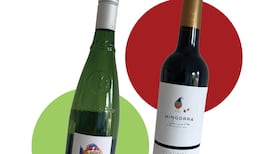‘I nternational” or “world” grape days are becoming fashionable in the wine industry. On these occasions we are encouraged to celebrate the grape variety in question. I’m not sure which came first, but Grenache and Malbec have both had their own special days for a few years now.
There is International Chardonnay Day on May 25th, and World Sherry Day has also been established, something I heartily applaud. We are all encouraged to host our own sherry events for the occasion, although the website (worldsherryday.com) says the celebration runs from May 20th to 26th, which sounds more like World Sherry Week.
Malbec World Day on April 17th appeared to have morphed into Argentina Day. Malbec is originally a French grape variety and is still important in a few outposts in France such as Cahors, but Argentina has by far the largest plantings of Malbec worldwide. To mark the day, the Argentinian embassy in Dublin organised a very good tasting, where wines made from a wide range of grape varieties were on show, although the majority were Malbec.
Being something of a contrarian, I decided to ignore the rows of Malbec and concentrate on Cabernet Sauvignon.
I have some sympathy for the Cabernet producers. Malbec has been grabbing all the international attention recently, particularly in the US, where steak with Malbec has become a fashionable choice (to the chagrin of Californian Zinfandel producers, I would imagine).
This has meant that some Argentinian producers are finding it difficult to sell their Cabernets. One table at the Embassy’s tasting had a 2007 Cabernet alongside a 2011 Malbec. I was told the producer could not get rid of his Cabernets and was several vintages behind.
Cabernet Sauvignon, the backbone of many great Bordeaux wines, has adapted well to other climates and soils. Like Chardonnay, it usually retains some of its original taste profile while taking on local character.
California, Chile and Australia have all been extremely successful in producing inexpensive wines with their own individual stamp. Making high-quality wines has proved more complicated. Cabernet matures late in the growing season, and if unripe it can be a bit green and herbaceous. All the great examples of Cabernet from Bordeaux, the Napa Valley in California, western Australia and Coonawarra in southern Australia combine a delicate balance of perfectly ripe fruit, good acidity and plenty of tannins.
Argentina, with its warm climate, has traditionally produced plenty of gutsy, rich Cabernets with masses of ripe cassis fruits. Thanks to the hot weather the tannins are riper too, making for lushly textured, almost velvety wines. This can be seductive initially, but often palls after one or two glasses, unless you like alcoholic Ribena.
However, as with Argentinian Malbecs, there is an increasing trend towards lighter, fresher Cabernets, often from vines grown at higher altitudes (Argentina has some of the world’s highest vineyards). Cabernet is also often blended with Malbec, or Merlot, as happens in Bordeaux.
The average Argentinian eats almost 60 kilos of beef a year. The more heavyweight Malbecs, with their robust flavours, go perfectly with steak; the lighter versions work well with other beef dishes. However, the same applies for full-bodied Cabernets, which go well with steak or roast beef, and probably even better with roast and grilled lamb.
In this week’s bottle selection, I feature four styles of Cabernet. For additional stockists of these wines, see irishtimes.com/life-and-style/food-and-drink/drink.
Jean Bousquet is a French winemaker who moved to the Tupungato Valley, where he established an organic winery. Tupungato is one of the higher, and therefore cooler, regions of Mendoza. The Bousquet wines reflect this, as they have an attractive freshness and liveliness.
Pascual Toso uses well-known Californian winemaker Paul Hobbs to assist with making its wines. I have always found them to be good-value entry-level options.
Alpamanta is owned by Danish-Austrian Andrej Razumovsky, who makes all his wines biodynamically. “As a European, I like the European style of wine, but still Argentinian,” he says. “I don’t want over-jammy wines.” I liked his wines, which had fine, elegant fruit.
Lastly, Luigi Bosca is one of the leading family-owned producers in Argentina. It is responsible for La Linda Cabernet, which I enjoyed. But the Gala II, a blend of Cabernet Sauvignon with 10 per cent Cabernet Franc and 5 per cent Merlot, was delicious.
jwilson@irishtimes.com










